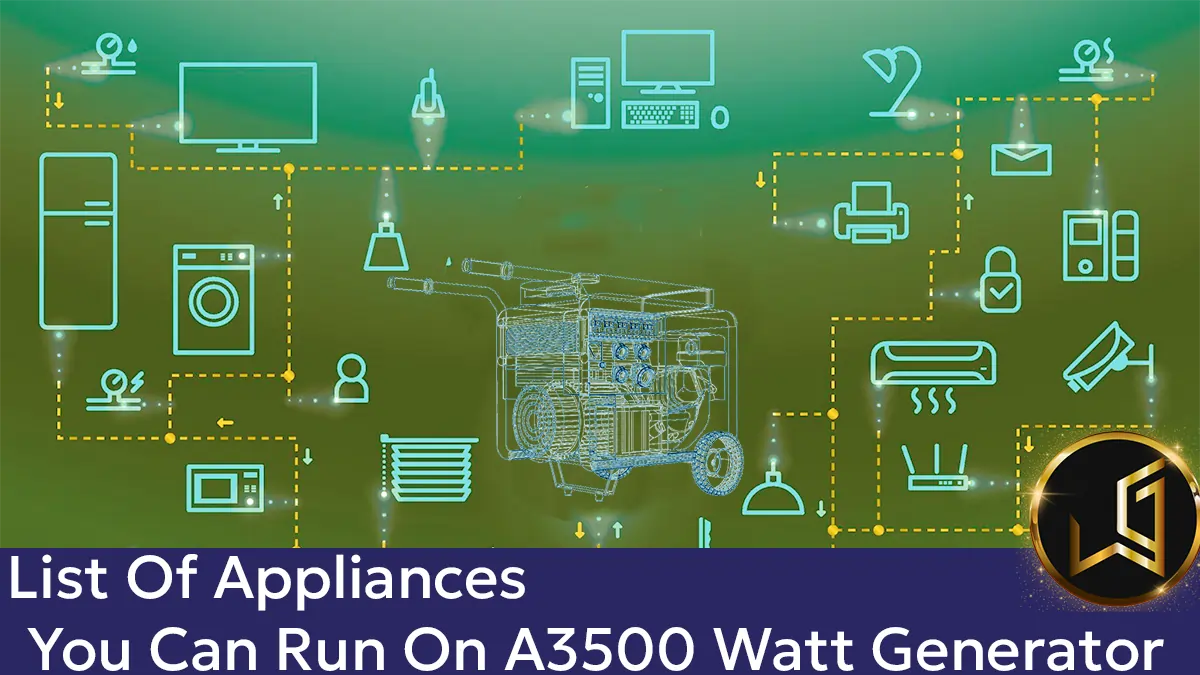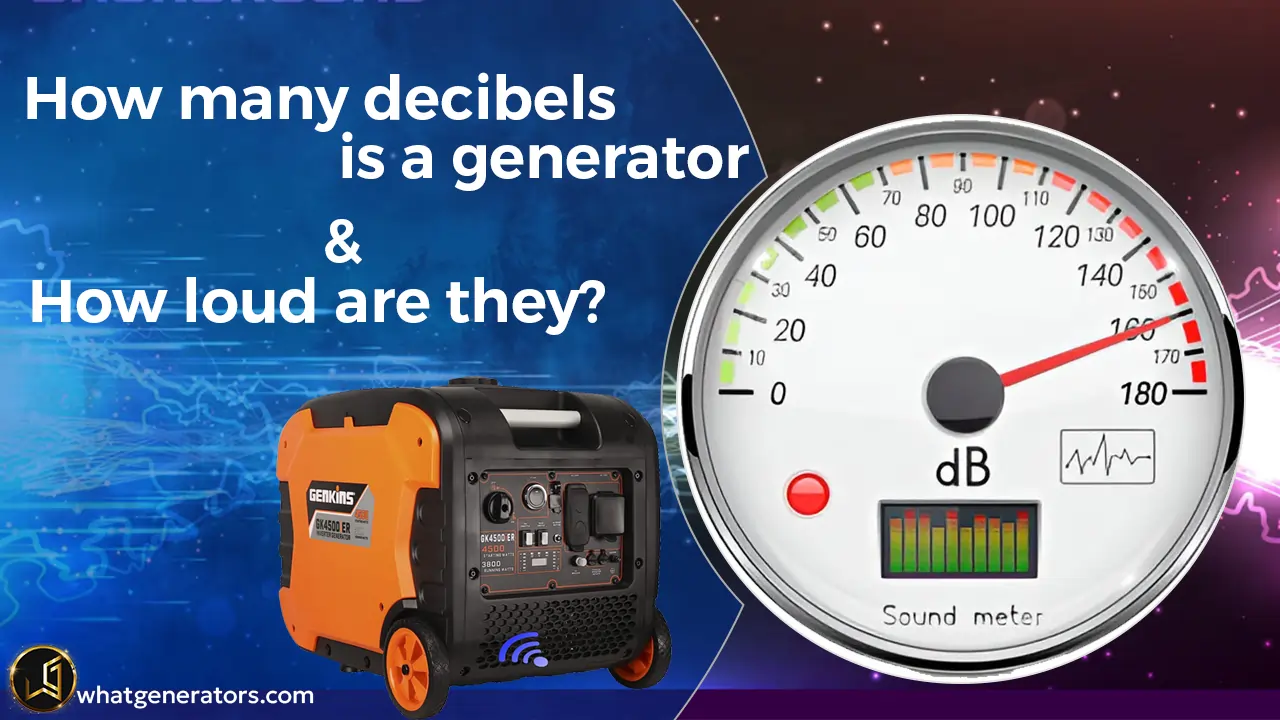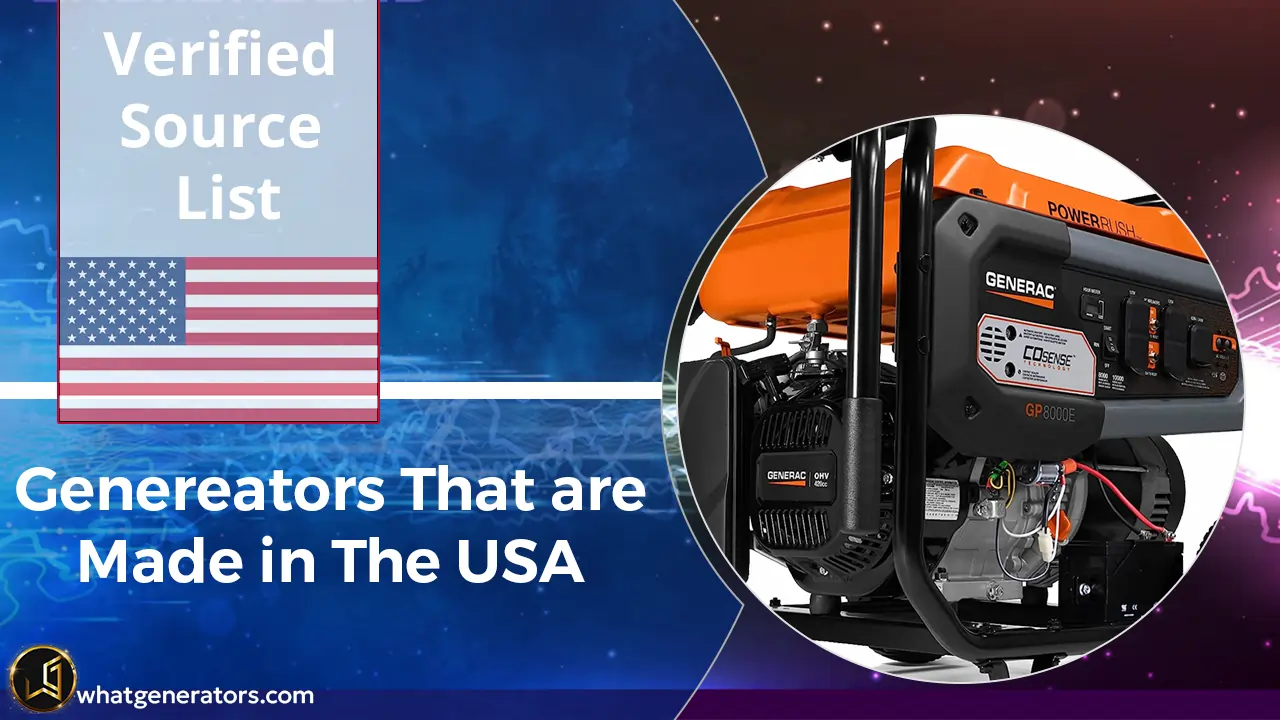
In case you’re searching for a 3500 W portable generator. There must be a question in your mind about the appliances does a 3500 Watt generator can run? Don’t worry; most of our customers need to know what wattage they need for their requirements.
In this research, we will discover the appliance that a 3500-watt generator can light up during a power outage or outdoor use.
UNDERSTANDING GENERATOR WATTAGE
A generator, a device that produces electrical energy, is rated by its wattage, indicating how much electricity it can generate. The electrical output is typically measured in watts or kilowatts.
Generators with a smaller capacity can produce limited electricity, usually enough to power a few small appliances or lights. These generators typically range from 1,000 to 2,000 watts in power output.
Electricity output can vary depending on the size of the generators. Bigger generators can produce more electricity, powering an entire house or large building. The output can range from thousands to even millions of watts.
When selecting a generator, choosing one with sufficient wattage to power the desired appliances is important. Opting for a larger generator will result in optimal performance, whereas choosing a smaller one could result in cost and energy savings.
TYPE OF GENERATOR & THEIR POWERING CAPABILITY
Generators come in different types, and their powering capability depends on their design and size. Here are some common types of generators and their typical powering capabilities:
Portable Generators:
These generators are smaller and are commonly used for camping or as backup power for a few essential appliances during outages. They typically range from 1,000 to 10,000 watts.
Inverter Generators:
Inverter generators are suitable for sensitive electronics, providing cleaner and more stable power. They are also portable and have wattage ranging from 1,000 to 10,000 watts.
Home Standby Generators:
Generators that can power an entire house, from lights to HVAC systems, can be permanently installed in homes with wattage ranging from 5,000 to 20,000 or more.
Industrial Generators:
Generators designed for use in commercial and industrial settings are called industrial generators. They provide power to factories, hospitals, and large facilities. They are built for heavy-duty use and can have wattage ranging from 20 kW to several MW.
Diesel Generators:
Diesel generators are commonly used in remote or critical areas due to their reliable power supply. They can range from a few kilowatts to multiple megawatts.
Natural Gas Generators:
Generators powered by natural gas are frequently utilized as backups in large homes and businesses. Their capacity ranges from a few kilowatts to several megawatts.
LIST OF APPLIANCES THAT CAN RUN BY A 3500-WATT GENERATOR
So, what exactly can a 3500-watt generator run? Here are some examples:
Here’s a list of 50 appliances and tools categorized and their wattage requirements. Please note that the wattage can vary slightly depending on the specific make and model of the appliance or tool.
KITCHEN APPLIANCES:
- Microwave (800-1,200 watts)
- Refrigerator (600-800 watts)
- Toaster (800-1,500 watts)
- Coffee Maker (800-1,500 watts)
- Electric Kettle (1,000-1,500 watts)
- Blender (300-1,000 watts)
- Dishwasher (1,200-1,500 watts)
- Stand Mixer (250-800 watts)
- Rice Cooker (300-1,200 watts)
- Food Processor (400-1,200 watts)
HOUSEHOLD APPLIANCES:
- Air Conditioner (Window Unit, 1,000-1,500 watts)
- Electric Heater (1,000-1,500 watts)
- Clothes Dryer (4,000-6,000 watts)
- Washing Machine (1,200-2,000 watts)
- Vacuum Cleaner (800-1,500 watts)
- Iron (1,000-1,800 watts)
- Hair Dryer (800-1,800 watts)
- Ceiling Fan (50-100 watts)
- Electric Blanket (200-400 watts)
- Space Heater (1,000-1,500 watts)\
ENTERTAINMENT APPLIANCES:
- Television (LCD/LED, 100-400 watts)
- Gaming Console (150-300 watts)
- Stereo System (50-1,000 watts)
- DVD/Blu-ray Player (15-30 watts)
- Soundbar (50-300 watts)
- Cable or Satellite Box (20-50 watts)
- Home Theater System (500-1,000 watts)
- Computer Monitor (15-100 watts)
- Subwoofer (100-300 watts)
- Projector (200-400 watts)
WORK SITE (Outdoor) TOOLS:
- Circular Saw (1,000-2,500 watts)
- Electric Drill (500-1,200 watts)
- Air Compressor (1,000-2,500 watts)
- Welder (3,000-8,000 watts)
- Angle Grinder (800-2,000 watts)
- Chainsaw (1,000-2,500 watts)
- Power Washer (1,200-2,500 watts)
- Electric Lawn Mower (1,200-2,500 watts)
- Electric Chainsaw (1,200-2,500 watts)
- Bench Grinder (500-1,000 watts)
OFFICE USED APPLIANCES:
- Desktop Computer (300-800 watts)
- Laptop (30-150 watts)
- Laser Printer (300-1,000 watts)
- Scanner (50-150 watts)
- Fax Machine (100-400 watts)
- Desk Lamp (20-100 watts)
- Shredder (100-200 watts)
- Space Heater (1,000-1,500 watts)
- Paper Cutter (100-300 watts)
- Electric Stapler (20-100 watts)
Remember that the total wattage of all appliances and tools you plan to run simultaneously should be, at most, the capacity of your 3,500-watt generator to prevent overloading. Additionally, some motor devices, like refrigerators and air conditioners, may have startup surges that temporarily require more power than their running wattage.
Is a 3,500-watt Generator Suitable For Your Power Needs?
A 3,500-watt generator can be a suitable choice for power needs that don’t require much electricity. It’s important to note that the wattage of a generator refers to its output capacity, and different appliances and devices require different amounts of power to function.
For example, a refrigerator typically requires around 600–800 watts, while a window air conditioner may need 1,200–1,500 watts.
With a 3,500-watt generator, you should be able to power smaller appliances and electronics like laptops, TVs, and lights without any issues. However, you want to power more oversized items like a central AC unit or an electric water heater. In that case, you’ll likely need a higher-wattage generator.
It’s also essential to consider the duration of use when selecting a generator. A 3,500-watt generator may be suitable for short-term power outages. Still, you anticipate more extended periods without electricity. In that case, you should invest in a generator with a higher wattage rating or additional fuel capacity.
When deciding on a generator, it’s crucial to assess your specific power needs and choose a model that can provide sufficient power for your needs.
SURGE WATTAGE VS CONTINUOUS WATTAGE
The main difference between the running and starting wattage of a generator is the amount of power it can produce. Running wattage refers to the continuous power output that a generator can sustain over an extended time, typically measured in watts or kilowatts.
Starting wattage, on the other hand, refers to the extra burst of power that a generator can provide for a short time to start up appliances or devices.
Continuous Wattage:
When it comes to generators, the running wattage is simply the amount of power the generator can continuously provide over an extended period. This is usually measured in watts or kilowatts and is a critical factor to consider when choosing the right generator for your needs.
The running wattage will vary depending on the specific make and model of the generator—still, the more powerful the generator, the higher the running wattage.
Surging Wattage:
The starting wattage of a generator refers to the amount of power the generator can provide for short bursts of time to start up appliances or devices that require more energy than to continue running. I also referred to surge or peak wattage, typically much higher than the running wattage.
For example, a refrigerator may only require 600 watts to run, but it could require 1800 watts to start up. Choosing a generator with enough starting wattage capability is essential to handle the startup needs of all the appliances and devices you plan to run during a power outage or other emergency.
In summary, understanding a generator’s running and starting wattage is crucial when selecting the right generator for your needs. The running wattage provides a continuous power supply. In contrast, the starting wattage provides the additional power needed to start up larger appliances or devices.
When calculating your power requirements, take both running and starting wattage into account to ensure that your generator can handle everything you need.
DETERMINING YOUR REQUIRED WATTAGE

Calculating the required wattage of a generator for your needs involves a few simple steps:
you can simply visit the CAT Website to calculate your required generator or follow the easy steps.
- List all the appliances and devices you want to run during a power outage or other emergency.
- Determine the running wattage of each appliance and device. You can find this information on the product’s label or the owner’s manual.
- Add up the total running wattage of all the appliances and devices you want to run simultaneously. You will get the minimum amount of continuous power output that your generator will need to provide.
- Determine the starting wattage of each appliance and device. As mentioned earlier, many appliances and devices require more power to start up than they do to continue running. This information can also usually be found on the product’s label or the owner’s manual.
- Add the total starting wattage of all the appliances and devices you want to run simultaneously. This will give you the additional power needed to start these devices.
- Add the total running and starting wattage together to get the total wattage needed from your generator. This will give you the minimum wattage rating your generator should have to meet your needs.
It’s worth noting that this is a general guide, and certain appliances and devices may have specific generator requirements or recommendations. Refer to the owner’s manual or contact the manufacturer to clarify your power needs.
Here is a simple formula to check your required wattage:
You want to power a refrigerator (running wattage of 600 watts), a sump pump (running wattage of 800 watts), and a space heater (running wattage of 1500 watts). The space heater has the highest starting wattage at 3000 watts.
Total Running wattage = 600 + 800 + 1500 = 2900 watts. The highest starting wattage is 3000 watts.
Total Wattage Needed = Total Running Wattage + Highest Starting Wattage = 2900 + 3000 = 5900 watts
Therefore, you would need a generator that can produce at least 5900 watts to power all the appliances and devices on your list.
Can I run my appliances on a 3500-watt generator continuously?
Whether or not you can run your appliances continuously on a 3,500-watt generator depends on the specific devices you’re trying to power and their power consumption levels. Most small to medium-sized household appliances, such as lights, TVs, laptops, and refrigerators, typically use less than 1,000 watts.
If you add up the rated wattage of all the devices you plan to use at once, the total should be, at most, the peak capacity of your generator (in this case, 3,500 watts).
However, it’s important to note that running appliances continuously for an extended time can cause the generator to overheat and potentially fail.
I always recommend taking breaks between usages or investing in a higher-capacity generator if you anticipate the need for continuous power supply for long periods.
Additionally, it’s crucial to follow all safety guidelines when using a generator, including proper ventilation and placement, regular maintenance, and avoiding overloading the generator.
Familiarize yourself with the manufacturer’s instructions and consult a professional if you have concerns about safely operating your 3,500-watt generator.
Note: Portable generators are designed to run for 6–12 hours continuously.
FAQ:
Can you give me an example of two appliances that a 3500-watt generator can run simultaneously?
Yes, a 3,500-watt generator can typically power two smaller appliances or electronics simultaneously, such as a refrigerator, a laptop, a TV, and a few lights.
What should I remember when powering multiple devices with a 3,500-watt generator?
Calculating the total wattage of all the devices you plan to use simultaneously is essential to ensure it is within the generator’s capacity.
It would be best to consider the starting wattage of specific appliances, such as refrigerators and AC units, which require a surge of power to start up. It’s generally recommended to stagger appliance usage and avoid running high-wattage items simultaneously.
Are there any appliances or electronics I should avoid using simultaneously with a 3,500-watt generator?
You should avoid running high-wattage appliances like electric water heaters, central air conditioning units, and electric stoves or ovens simultaneously. These devices typically require more power than a 3,500-watt generator can provide and could cause damage to the generator or your appliances.
How long can I expect a 3,500-watt generator to provide power if I run multiple devices simultaneously?
The duration of the power supply will depend on the specific devices being powered and their power consumption levels.
If you’re running several devices simultaneously, the generator may need to be refueled more frequently. Typically, a 3,500-watt generator can run for around 8–12 hours on a full gas tank, but this may vary depending on usage.
Is running a 3,500-watt generator at total capacity for an extended period safe?
Running a generator at total capacity for an extended time can cause overheating and damage to the generator.
It’s recommended to avoid running a generator at total capacity for more than a few hours at a time. Investing in a higher-wattage generator may be better if you need multiple devices continuously.
Can a 3500-watt generator run AC?
A 3500-watt generator can run 1 to 1.5 tons AC. It is recommended to check your AC wattage before using the generator.
Will a 3500-watt generator run a 30-amp camper?
Yes, a 3500-watt generator can easily run a 30-amp camper, but for a long period, you must use a high-rated generator.
What size generator do I need for a 30 ft camper?
For a 30 ft camper, it is recommended to use a generator that has more than 4000 watt output.







